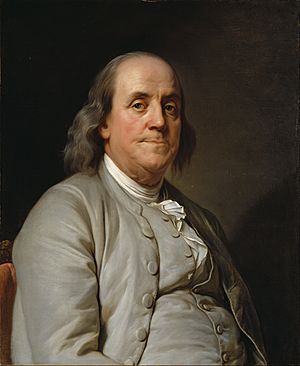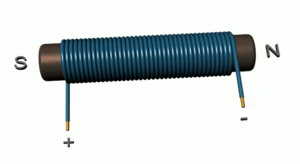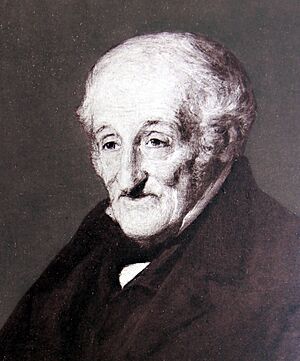History of electrical engineering facts for kids
The history of electrical engineering is super interesting! It's all about how we learned to understand and use electricity, which powers almost everything around us today. From ancient times to modern computers, people have been figuring out the amazing secrets of electricity.
Contents
Early Discoveries
Long, long ago, people knew about electric fish. These fish could give a shocking jolt! Ancient Egyptian writings from around 2750 BCE called them "Thunderer of the Nile." They even thought these fish protected other fish. Later, ancient Greeks, Romans, and Arabs also wrote about electric fish like electric catfish and rays. They knew these shocks could travel through objects. Sometimes, people with headaches or other pains were told to touch these fish, hoping the shock would cure them.
Around 600 BCE, a Greek thinker named Thales of Miletus noticed something cool. If you rubbed amber (a fossilized tree resin) with cat's fur, it could attract light things like feathers. He even saw tiny sparks if he rubbed it enough! This was an early discovery of static electricity.
About 450 BCE, another Greek philosopher, Democritus, had a big idea. He thought everything was made of tiny, invisible, and unbreakable particles called "atoms." He was right that atoms are always moving and that there's empty space between them. He was a bit off by thinking atoms came in different shapes for different objects, but his idea was still very advanced for his time!
In 1938, an object called the Baghdad Battery was found in Iraq. It's from about 250 BCE and looks like an early battery. Some people think it might have been used for electroplating (coating one metal with another), but there's no clear proof.
17th Century: New Words and Ideas
For thousands of years, electricity was mostly a mystery. But in 1600, an English scientist named William Gilbert started studying it more deeply. He looked at how magnets work and how rubbing amber creates static electricity. He even invented the word "electricus" (meaning "like amber" in Latin) to describe this attracting power. This is where our words "electric" and "electricity" come from! They first appeared in a book in 1646.
Later, Otto von Guericke showed that static electricity could also push things away. Another scientist, Robert Boyle, also did important work on electricity during this time.
18th Century: Getting Serious About Electricity
By the 1700s, studying electricity became very popular. People were excited by all the new discoveries!
In 1705, Francis Hauksbee made a cool discovery. He put a little mercury in a glass ball, removed most of the air, and then rubbed the ball. When he touched the outside, it glowed brightly enough to read by! This glow was similar to St. Elmo's Fire (a natural electrical phenomenon). This experiment was a big step towards creating modern gas-discharge lamps, like neon lights. Hauksbee kept experimenting and published a book about his findings in 1709.
Stephen Gray found out that some materials, like metals, let electricity flow easily (these are called conductors), while others, like glass, block it (these are called insulators). Building on his work, C. F. du Fay came up with a "two-fluid" idea of electricity.
One of the most famous names in electricity is Benjamin Franklin. In 1752, he supposedly flew a kite in a thunderstorm with a metal key attached. Sparks jumped from the key to his hand, proving that lightning is a form of electricity! He also explained how a Leyden jar (an early device to store electric charge) worked.
In 1791, an Italian scientist named Luigi Galvani discovered bioelectricity. He showed that electricity is how our nerves send signals to our muscles. Then, in 1800, Alessandro Volta created the first true battery, called the voltaic pile. It was made of stacked layers of zinc and copper. This battery gave scientists a steady source of electricity, much better than the static electricity machines they used before.
19th Century: The Electric Age Begins
The 1800s were a huge time for electricity! The first practical use of electricity was electromagnetism. In 1825, William Sturgeon invented the electromagnet, which is a magnet created by electric current.
Electromagnets were soon used in the first practical telegraph system. William Fothergill Cooke and Charles Wheatstone developed a telegraph that used needles to point to letters. This allowed messages to be sent over long distances using electricity. Railways quickly adopted telegraphs to communicate between stations, which helped make train travel safer and more organized.
Electrical engineering started becoming a real job in the late 1800s. People built a worldwide network of electric telegraphs. The first groups for electrical engineers were formed in the UK and US. While it's hard to pick just one "first" electrical engineer, Francis Ronalds was a pioneer. In 1816, he built a working electric telegraph and imagined how electricity could change the world. He was seen as a leader by other early electrical engineers.
Scientists kept learning more about electricity. In 1827, Georg Ohm figured out the relationship between electric current and voltage (how much "push" electricity has). This is now known as Ohm's Law. In 1831, Michael Faraday discovered electromagnetic induction, which is how you can create electricity using magnetism. He also developed the homopolar generator, an early electric generator. These discoveries were key to modern electrical generators, which create electricity using magnetic fields. In 1866, Werner von Siemens invented the industrial electric generator, which made many other inventions possible.
In 1873, James Clerk Maxwell published his famous equations that brought together electricity and magnetism. These equations helped scientists understand how electric and magnetic fields work together.
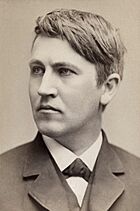
By the late 1800s, universities started offering degrees in electrical engineering. The Darmstadt University of Technology in Germany created the first electrical engineering department in 1882. Soon after, other universities like Massachusetts Institute of Technology and Cornell University in the US, and University College London in the UK, followed suit.
Electricity became much more common in daily life. Cities began installing electric streetlights using arc lamps. After Thomas Edison invented a practical light bulb for homes, he started the world's first public electric power company in 1882. It used a 110-volt direct current (DC) system. However, new inventions like the transformer led to alternating current (AC) becoming the standard for distributing electricity, as it could be sent over longer distances more easily. This led to a famous "war of the currents" between Edison's DC system and George Westinghouse's AC system. AC eventually won out for widespread power distribution.

By the end of the 19th century, Maxwell's equations were seen as a cornerstone of physics. They were also being used in new technologies like radio, telegraphs, telephones, and electric power. Charles Proteus Steinmetz was a key figure who helped develop the math behind alternating current, making it easier for engineers to use.
Radio and Early Electronics
Many scientists and inventors helped create radio and electronics. In 1888, Heinrich Hertz showed that electromagnetic waves (radio waves) really existed. This led inventors like Guglielmo Marconi and Alexander Popov to develop early radio systems.
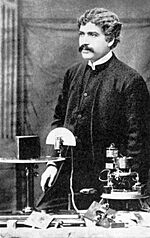
Jagadish Chandra Bose explored very high-frequency radio waves (millimeter waves) in the 1890s. He also invented the crystal detector in 1901, which used semiconductors to detect radio waves.
20th Century: The Electronic Revolution
In 1904, John Ambrose Fleming invented the first radio tube, called the diode. This was a big step for electronics.
Reginald Fessenden realized that to send voices over radio, you needed a continuous wave. In 1906, he made the first radio broadcast of voice. Also in 1906, Robert von Lieben and Lee De Forest independently developed the triode, which could amplify (make stronger) electronic signals. This was crucial for radio and later for television, which Edwin Howard Armstrong helped make possible in 1931.
In the 1920s, people became very interested in using electricity in their homes. Exhibitions showed "homes of the future." In the UK, the Electrical Association for Women was started in 1924 to encourage women to get involved in electrical engineering.
World War II and Beyond
World War II (1939-1945) brought huge advances in electronics. Radar technology improved greatly, and the magnetron (a key part of radar) was invented in 1940. Radio communication and guidance for aircraft also developed rapidly. An early electronic computer called Colossus was built to break secret German codes. Advanced hidden radio transmitters and receivers were also created for secret agents.
The US developed a system called the Green Hornet to scramble phone calls between leaders like Winston Churchill and Franklin D. Roosevelt. It added noise to the signal, which was then removed at the other end. The Germans could never break this system.
After the war, many studies on radio, circuits, and electromagnetism were published, sharing all the new knowledge. In 1941, Konrad Zuse presented the Z3, the world's first fully working and programmable computer.
Post-War Years and Modern Electronics
Before World War II, the field was mostly called "radio engineering" and focused on communication and radar. You usually studied it as part of a physics degree.
After the war, as new devices like TVs, audio systems, and later computers appeared, the field grew. In 1946, the ENIAC (Electronic Numerical Integrator and Computer) was built, starting the age of modern computing. These powerful computers allowed engineers to create amazing new technologies, like those used in the Apollo missions and the NASA Moon landing.
By the mid-1950s, "radio engineering" slowly changed to "electronics engineering." It became its own university subject, often taught alongside electrical engineering because they shared many ideas.
Solid-State Electronics: The Tiny Revolution


A huge breakthrough was the invention of the transistor. The first working transistor was created by John Bardeen and Walter Houser Brattain in 1947, working with William Shockley at Bell Labs. They later invented the bipolar junction transistor in 1948. These early transistors were a bit big, but they opened the door for much smaller electronic devices.
Then came the integrated circuit (IC), or microchip. The first ICs were invented by Jack Kilby in 1958 and Robert Noyce in 1959. These chips allowed many electronic components to be put onto a single tiny piece of material.
The MOSFET (metal–oxide–semiconductor field-effect transistor) was invented by Mohamed Atalla and Dawon Kahng in 1959. This was a game-changer! It was the first truly compact transistor that could be made very small and produced in huge numbers. The MOSFET completely changed the electronics industry and became the most widely used electronic device in the world.
-
John Bardeen, William Shockley, Walter Brattain – transistor (1947)
-
Mohamed M. Atalla – MOSFET transistor (1959)
-
Robert Noyce – integrated circuit chip (1959)
-
Gordon Moore –
Moore's law (1965) -
Federico Faggin – microprocessor (1971)
The MOSFET made it possible to create very complex integrated circuits. This led to Moore's law, a prediction by Gordon Moore in 1965, which said that the number of transistors on a chip would double about every two years. This amazing miniaturization has continued, leading to huge changes in technology, our economy, and how we live.
The Apollo program, which landed astronauts on the Moon in 1969, relied heavily on these new semiconductor technologies, including MOSFETs and integrated circuit chips used in the Apollo Guidance Computer.
The development of MOS integrated circuits in the 1960s led to the invention of the microprocessor in the early 1970s. The first single-chip microprocessor was the Intel 4004, released in 1971. It was designed by Federico Faggin, Marcian Hoff, Stanley Mazor, and Masatoshi Shima. This tiny chip started the personal computer revolution! The Intel 4004 was a 4-bit processor, and it was followed by the 8-bit Intel 8080 in 1973, which made the first personal computer, the Altair 8800, possible.
See also
- History of electronic engineering
- History of electromagnetic theory
- History of radio


